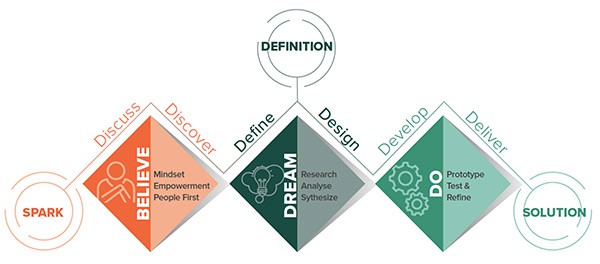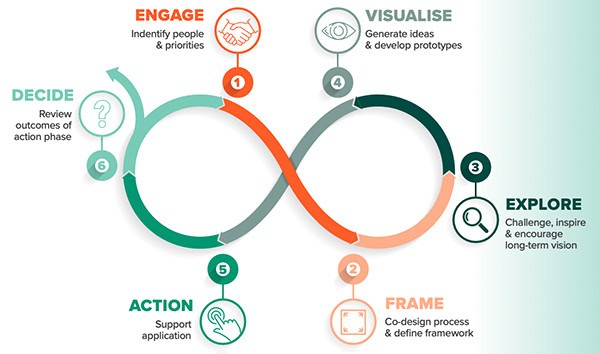Article 7
What Does our Six Step to Co-Design Process Look Like?
This article is the seventh in a series to share information, resources, answer questions and offer tips and tools to support you as you work across the Southern NSW Innovation Hub and beyond.
The Hub is implementing Co-design. This is an approach to designing “with” and not “for” or “to” people. These regular articles are designed to challenge, teach, and motivate you to explore and use Co-design in your work (and it will have relevance beyond the work environment too.)
All updates are written by the team of Jo Eady, a human centred facilitator, strategic designer with a keen interest in social change based in Victoria and Dale Stringer, innovation specialist and key knowledge broker with Southern NSW Innovation Hub.
Reminder – our approach to Co-Design
Let’s take a quick review of our approach to Co-design before we move on to our Co-design process. Yes, we have an Approach and a Process. It’s important to remember that the Co-design process sits inside a People Centred Approach called the Triple Diamond with design being one of the approach elements. This diamond supports the conscious awareness, planning and facilitation of change from the spark of an idea to its definition resulting in a solution. Here’s a reminder of what the Triple Diamond looks like. Here, you can see that the design process is embedded in the larger approach.
The Triple Approach Diamond

- Discuss: Identify and talk about what’s going on and support people to ideally see what they’d like to see happen. See if issues / topics / opportunities of shared interest emerge.
- Discover: Name the issue / topic / opportunity and unpack it to the extent that you have a true understanding of it and its impact.
- Define: Be creative and work together to see and define the issue / topic / opportunity in a new way.
- Design: Create a draft prototype. A model of what you propose. Keep it simple
- Develop: Seek further inspiration. Design with others and ensure it gives answers to the defined problem, issue or opportunity.
- Deliver: Test out solutions. Keep it small scale for now. Make decisions about what will and won’t work and which solutions to improve.
Define before design
In our experience we see some common things occur when people start implementing the Co-design Approach and Process. The main one is when facilitators don’t take enough time to plan. This usually sees limited engagement with participants to create a shared group experience where the issue, topic or opportunity can be fully discussed and defined. Worse still is when the facilitator acts as a knowledge expert and brings an issue to the group with a solution or two! The define stage will hold a group together by giving it a common purpose. It’s creative and helps people to see the issue/topic/opportunity in a new way. Participants should easily buy in to this as it should be something that they all see value in working on. We see facilitators move quickly to the design stage without engaging and supporting participants to define the issue, topic or opportunity. The key here is to carefully define with your group before you commence the design process. Be careful not to take on the role of ‘fixer’.
Our six step Co-Design process
The real key to the Co-design stage in the Triple Diamond Approach is to plan and facilitate activities to support participants to work together to create suggested options and solutions to the issue/ topic/opportunity the group is addressing. The role of the facilitator is to take the group though the following 6 step process. This means engaging (Step 1) with the group and supporting them to agree on the Process and framework (Step 2) the group will use, including timelines. From there the facilitator helps the group to explore (Step 3) options by taking them on a field trip, introducing research or a guest speaker to challenge their current thinking and inspire long term curiosity. The outcome of this is for the group to visualise (Step 4) what the solution/prototype might look like. The group is then supported to action (Step 5) the solution or prototype on their farm, in their enterprise or community and see the changes it makes. The final step is for the group to review outcomes of the action step and decide (Step 6) what actions they wish to keep, modify and or discard. It’s at this step that the group can decide if and how they might wish to continue to meet and for what purpose or to disband.

You will see we have represented our Six Step Co-design Process as an infinity loop to signify that it’s iterative. Effective Co-design is required so that groups are guided through the six steps rather than getting caught at Steps 1 – 3 where groups are initiated, commence engagement and identify and prioritise issues/topics/opportunities and move no further. It’s essential to facilitate your group through Steps 4 – 6. This is where Co-design works really well as its only through collaboration with ALL users of a system, problem, topic or opportunity that ideas and options can be created to move forward.
Watch out for participants who just want you to “fix it”, Co-design supports the group to co-create outcomes leading to more relevant and a greater uptake of outcomes resulting in increased change and value for all.
Over to you
We hope this article gives you food for thought, and that it supports you when planning your next Co-design initiative.
Click here to see all Articles in this Series.
FURTHER INFORMATION
We’d love to hear from you. Please email through any comments or questions you have. And if you have topics you’d like to see addressed in future articles, please share them here or call 0419 912 879. Feel free to share this article with those you think might find it of value too. For more information about the Southern NSW Innovation Hub please contact Dale Stringer or call 0428 409 680
Brief Us
Do you need help to...
Shape your ideas
Formulate a project?
Create positive change through leadership?
Or, simply answer a question?
RuralScope would love to help. Take a few minutes to brief us in the form and our team will respond within 48 hours.
